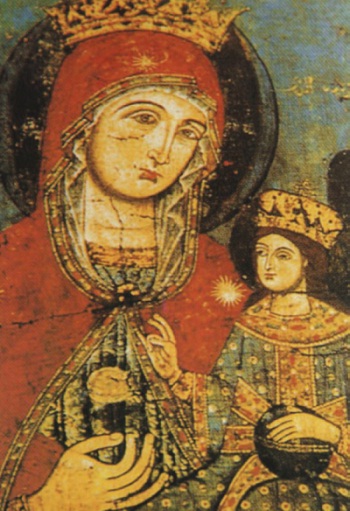In most faiths and beliefs there are specific symbols, signs and ways of expression related to this belief or faith. Believers usually tend to respect, and sanctify these symbols and signs to the degree of sacredness, and they depict them as an expression of piety and devotion. Christian artists of Aleppo adopted particular methods that became central elements in the art of iconography in theregion.
Linguistically, in Greek icon means picture. The art of drawing icons tended to be typical and symbolic rather than realistic. The icon is a picture that reflects piety and deep faith since it expresses love of Jesus Christ, Mary the Virgin, the apostles and biblical scenes. Some icons were sanctified to the degree of sacredness and worship. Emperor Leon the Syrian of Byzantium fought this tendency and returned icons to their normal status as mere works of art. But believers continued looking at icons with great respect rather than just pieces of art.
Most of the icons and religious pictures in Syrian churches and monasteries were drawn by Syrian monks. This art started in the sixth century when the picture of Jesus Christ appeared for the first time in Antioch in which Jesus was pictured as a handsome man with a small beard and long hair. The picture was named “Syrian Christ” andreplaced an old one drawn by Apollon.
The oldest icon in Syria is that of the Virgin Lady of Damascus, now found in Lafalita, capital of Malta, drawn by an anonymous Syrian monk. Iconography started inByzantium and spread all over the world, but Syrian artists, as from the eighteenth century, painted icons of traditional subjects and of local style where costumes, furniture and ornamentations are of Syrian, mostly
Arabic Islamic influence, characterized by geometrical designs and Arabic calligraphy. In Deir Mar Mousa, in al Qalamoun, Islamic verses are still drawn on the walls of the monastery, a clear evidence of the correlation between the artist and the common beliefs embraced by people in his environment. Most famous Syrian iconographer is Yousefthe Painter (born in Aleppo in the second half of the 16th. Century). He was the first iconographer who left behind two icons now displayed in Beirut. His style was traditional tending to be shy of oriental realism. His son Neimasurpassed his father in affixing oriental style in drawingicons. He was very accurate in drawing details, clever in coloring faces with a clear interest in Arabic designs as background of his icons. His son Hanania followed his father’s style and painted icon of the “Last Judgment” now in the Armenian Cathedral of Aleppo, and a unique icon now in the Monastery of Balamand. His son Georgeousfollowed the same style alienating himself from the Byzantine classical school. His son Kirilius, also, continuedthe line of his father. When Abdallah Zakher, a calligrapher, started drawing icons he used to ornamentingthem with captions of respect and devotion. Aleppo’s artistscould found a distinguished style in iconography that distinguished them and made them masters of this art.Hundreds of icons were drawn by anonymous iconographers who tended not to sign them out of modesty.
 Few of them were signed by Shukrallah son of Wakim of Aleppo. Aleppo’s school of iconography is one of the most prominent schools in the east whose influence spread toDamascus, Homs and Jerusalem represented by the works of Hanna the Jerusalemite and Michael the Damascene.
Few of them were signed by Shukrallah son of Wakim of Aleppo. Aleppo’s school of iconography is one of the most prominent schools in the east whose influence spread toDamascus, Homs and Jerusalem represented by the works of Hanna the Jerusalemite and Michael the Damascene.

